March 14, 2014
Air Date: March 14, 2014
FULL SHOW
SEGMENTS
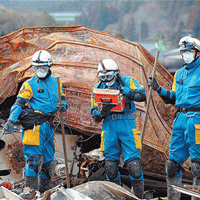
Fukushima Nuclear Meltdown Three Years Later
View the page for this story
It’s been three years since a tsunami caused the meltdown of three nuclear reactors at Fukushima, Japan. Dale Klein, an adviser to the Tokyo Electric Power Company, tells host Steve Curwood that workers have stabilized the reactors but leaking radioactive water is still a problem. (06:50)

Navy Rescuers Claim Radiation Sickness
/ Emmett FitzGeraldView the page for this story
US sailors from the carrier Ronald Reagan involved in the Fukushima relief effort are suing the Tokyo Electric Power Company over illnesses they say were caused by exposure to radioactive plumes from the meltdown. Living on Earth's Emmett FitzGerald reports. (06:15)

Petrochemical Boom on the Gulf Coast
/ Reid FrazierView the page for this story
Booming shale gas production has helped fuel a petrochemical boom. Reid Frazier of the Allegheny Front’s went to Port Arthur, Texas, to explore the economic benefits and the health concerns that result from this industry. (07:25)

BPA-Free Does Not Always Mean Safe
View the page for this story
Consumer worries and health concerns helped prompt the FDA to ban Bisphenol A (BPA) in children’s products. But an investigative report in Mother Jones finds replacement plastics may be just as hazardous. Report author Mariah Blake explains the evidence to host Steve Curwood. (10:15)
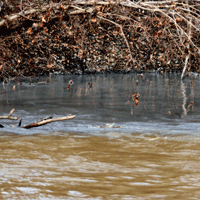
Beyond the Headlines:
View the page for this story
In this week’s trip beyond the headlines, Daily Climate publisher Peter Dykstra and Living on Earth host Steve Curwood discuss some surprising environmental rip-offs. (04:05)
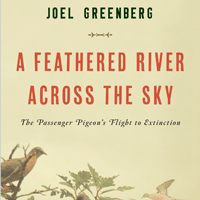
A Feathered River Across the Sky
View the page for this story
In the 19th century passenger pigeons numbered in the billions across North America. By 1914 they were extinct. Naturalist Joel Greenberg has written a book about the pigeon and its extinction called A Feathered River across the Sky, and he joins Steve Curwood to talk about lessons we can learn from its demise. (09:15)

Deer Miss
/ Mark Seth LenderView the page for this story
With no natural predators in the east US, the white-tailed deer population has ballooned, leading to numerous collisions with cars, that cost both lives and millions of dollars. Writer Mark Seth Lender had his own near collision on 1-95. (03:25)
Show Credits and Funders
Show Transcript
HOST: Steve Curwood
GUESTS: Dale Klein, Mariah Blake, Peter Dykstra, Joel Greenberg,
REPORTERS: Emmett FitzGerald, Reid Frazier, Mark Seth Lender
[THEME]
CURWOOD: From Public Radio International, this is Living on Earth. I’m Steve Curwood.
[THEME]
CURWOOD: Three years after the Fukushima nuclear meltdown, cleaning up thousands of tons of contaminated water at the site is still a problem.
KLEIN: The remaining isotope that they're going to have to determine what to do with is tritium. We know a lot about tritium. It's just one of the isotopes of hydrogen, so it's that infamous - how do you filter water out of water? You just can't do that economically.
CURWOOD: Also, why US sailors are suing the Fukushima plant operator, TEPCO. And what some said had happened to the passenger pigeon once it was hunted to extinction.
GREENBERG: One person wrote that the birds had all moved to Colombia, South America, lived in the jungles and changed their appearance so no one could recognize them.
CURWOOD: Passenger pigeons, plastics and more this week on Living on Earth. Stick around.
[NEWSBREAK MUSIC: Boards Of Canada “Zoetrope” from “In A Beautiful Place Out In The Country” (Warp Records 2000)]
ANNOUNCER: Funding for Living on Earth comes from Stonyfield Farm, makers of organic yogurt, smoothies and more.
Fukushima Nuclear Meltdown Three Years Later
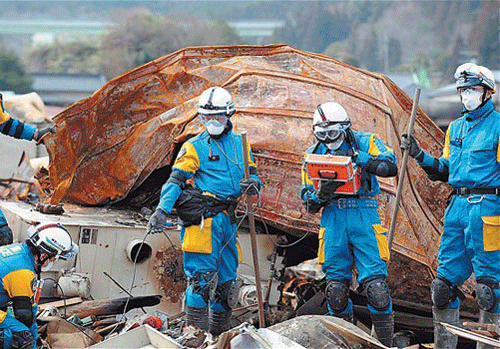
Workers struggle to clean up and stabilize the damaged Fukushima reactors. (Los Alamos National Laboratory)
CURWOOD: From the Jennifer and Ted Stanley Studios in Boston, this is Living on Earth. I’m Steve Curwood. Legend has it that an ogress called Adachigahara once lived in the region of Japan that includes Fukushima, catching travelers and eating them. Today, radiation is the ogress that stalks the area, after a powerful earthquake and tsunami three years ago killed more than 18,000 people. The wall of water also smashed into the Fukushima nuclear power complex causing three reactors to melt down and release a massive plume of radioactive particles. Three years on, the fires are out but there are still massive amounts of radioactive water to contend with. Dale Klein is a former chairman of the US Nuclear Regulatory Commission and now advises the Tokyo Electric Power Company on the clean-up effort. Welcome to Living on Earth.
KLEIN: Well, thank you, Steve. It’s a pleasure to talk with you today.
CURWOOD: So, it’s been three years since the nuclear reactors - the three of them - melted down there in Japan. What’s the situation like on the ground in Fukushima?
KLEIN: You know, Steve, it’s a mixed bag. There’s pockets of success, and there’s pockets of failures. So I think, overall, the main radiation is being contained, and that is from the formerly molten fuel in the reactors and in the spent fuel pools. So on the big picture for big safety issues things are OK. The frustrating part is just the water management, the continuing leaks, doesn’t help with public trust and confidence, and it is a complicated site.
CURWOOD: Talk to me about the contaminated water there, the radioactive water. How much of it is leaking out now?
KLEIN: Not much is leaking out. They have had problems with some old contaminated waters in tunnels. They have had problems with occasional leaks from tanks. They just had one from a few weeks ago, and they have a massive amount of water. They had a lot of water that they had collected during the accident, so they have about 1,000 tanks of contaminated water, and the water accumulation rate is at about 400 tons a day due to in-leakage. They’re getting inflow from ground water that makes that accumulation of 400 tons a day, and that’s just not sustainable for the long term. They have to have a long-term integrated management program, and that’s what we’ve been working at.
CURWOOD: So what is the long-term solution at this point?

Most of the radioactive contamination from the Fukushima meltdown was blown out to sea. (Sandia National Laboratories)
KLEIN: The long-term is they’re going to...they have several filter systems up and running now where they’re removing the radioactive elements, and then putting that cleaned water into other tanks. The remaining isotope that they're going to have to determine what to do with is tritium. We know a lot about tritium. It's just one of the isotopes of hydrogen, so it's that infamous - how do you filter water out of water? You just can't do that economically. So it’s a very low-energy level. It does not accumulate in the body, but it’s a very emotional issue of what to do with the water after everything is filtered but it still has some tritium in it. So they’ll have to go through an educational process to let people understand what the risks are, how they intend to insure safety, and that they will have no environmental consequences if they ultimately do a controlled release into the ocean.
CURWOOD: Water into the ocean...what would the environmental impact be of dumping massive amounts of water contaminated with tritium, radioactive tritium?
KLEIN: It would not be a problem. The IAEA has looked at that issue, the current regulatory body is looking at that issue, so there are standards for what safe levels of tritium are. And so they just need to go through a process to understand how they can ultimately, safely, with no impact on the environment release the tritiated water.
CURWOOD: So overall, how has the meltdown incident affected the people who live in the Fukushima area?
KLEIN: The area around the reactors themselves is like a ghost town. It’s very sobering to go through that site and see once thriving villages that had to be evacuated. It is very traumatic, I think, for those people who had to be removed from their homes, and the sooner they can safely return, I think the better it will be for the local citizens. The government is proposing to let people move closer around April of this year, so some of the areas look quite nice, the fields are clean, the rice paddies are back to normal conditions, the homes are rebuilt. As you approach the plant itself, there’s a lot of structural damage from a lot of the homes. And so you’ll see a lot of broken glass. Those areas have considerable damage, as well as higher levels of contamination, and those will just be isolated for some period of time.
CURWOOD: What have been the health effects so far?
KLEIN: Interestingly enough, the IAEA did a very comprehensive study, and from all the data that they’ve looked at and all the projections, it looks like there will be very, very little health impacts from the radiation. People were evacuated in a timely manner, most of the radiation that did escape went out to sea. From what we know today, even if there was radiation released, it will have a minimal impact on people’s health.
CURWOOD: What about the workers who went in to deal with the problems of the meltdowns?
KLEIN: From the measurements that we’ve seen, very few workers received very high levels of radiation. They also have talked about the “Fukushima 50”, the 50 workers that were there for an extended period of time. But from the data that they seen so far, there have been no adverse health effects from those Fukushima 50 workers.
CURWOOD: Nobody’s sick?
KLEIN: No one is sick. No cancer rates so far.
CURWOOD: Early on, one might see health effects on thyroid from the release of radioactive iodine. Those effects show up pretty early. What do you see along those lines?
KLEIN: We have not seen significant impacts from the iodine. The good news is people were evacuated. It was not the same situation that we saw in Chernobyl where it was covered up for a long period of time, and people were unnecessarily exposed to the Iodine-131. So they have not seen increases in thyroid cancer.
CURWOOD: By the way, you said much of the initial plume of these meltdowns went out to sea. Does that mean really more radioactive activity went away from the populated areas?
KLEIN: Yes, it did. Most of the radiation...the wind was blowing towards the east. So most of that radiation was carried away from the villages and the population centers.
CURWOOD: Dale Klein is a former chairman of the US Nuclear Regulatory Commission, and he’s on assignment now in Fukushima, Japan, advising the Tokyo Electric Power Company on the cleanup effort. Thanks so much for taking the time with me today.
KLEIN: Thank you, Steve. It was my pleasure.
Related links:
- TEPCO
- Check out this mini-documentary on the health impacts of Fukushima radiation
Navy Rescuers Claim Radiation Sickness

USS Ronald Reagan (Photo: Official US Navy Imagery, Flickr Creative Commons 2.0)
CURWOOD: While the official count of radiation illness from the Fukushima meltdown is remarkably low, intensive testing of children in the region has led to a spike in reported thyroid cancers, though it's unclear if this is due to the disaster, or the unprecedented screening.
Tsunami survivors near Fukushima were rapidly evacuated, but as Dale Klein explained, the wind probably blew most of the nuclear contamination out to sea. There, as part of the US relief effort Operation Tomodachi, the carrier USS Ronald Reagan and its task force sailed right into the plume of radioactive dust. Now many of the Navy crew are experiencing health problems they blame on exposure to radiation, and they’ve sued the Tokyo Electric Power Company, TEPCO. Living on Earth's Emmett FitzGerald has the story.
FITZGERALD: There’s a long list of illnesses affecting the Navy sailors who came to help at Fukushima.
BONNER: They’re suffering from leukemias, ulcers, brain tumors, testicular cancers, dysfunctional uterine bleeding, thyroid problems.
FITZGERALD: That’s Charles Bonner, an attorney from Sausalito, California representing the sick sailors and marines from the USS Ronald Reagan, and some of their children.
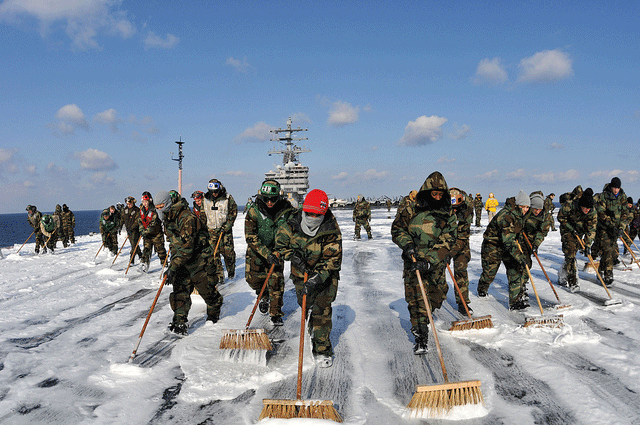
Sailors scrubbing the deck of the USS Ronald Reagan (Photo: Official US Navy Imagery, Flickr Creative Commons 2.0)
BONNER: This lawsuit includes two minors, one of whom was born right after the mother returned. She was pregnant on board but she did not know she was pregnant. And 8 months after she delivered a child who has various birth defects.
FITZGERALD: Another plaintiff, Lieutenant Steve Simmons, says he was below deck when he first heard that the ship’s water might be radioactive.
SIMMONS: They actually came across the intercom system of the ship letting everybody know we had a little problem, that we had actually sucked up contaminants into the water system.
FITZGERALD: That water system desalinates seawater for all the crew’s needs.
SIMMONS: I had already been up. I had already been showered. I had already been to the wardroom and had a couple glasses of water. I’d already filled up my water bottle a couple of times.
FITZGERALD: At first, Simmons played down any concerns he had about the radiation. He says he didn’t want people to panic. But two months after coming home, he got very sick. He blacked out several times, once while driving; lost over 20 pounds, and began running a steady fever. Over time, the muscles in his legs started to weaken until he could no longer walk.
SIMMONS: The muscle weakness just continued to progress, up my legs, into my arms, my hands. And now the signals aren’t getting from the brain to the bladder so I have to catheterize every four hours.
FITZGERALD: So far, Steve’s doctors can’t confirm any link between his illness and the radiation on the Reagan. But Charles Bonner says that his plaintiffs’ symptoms are consistent with radiation poisoning, and that so many are sick shows there’s a link.
BONNER: You would not expect to see this many illnesses in a young population - we’re talking about 21-year-olds, 22-year-olds.
FITZGERALD: So far over 100 people have signed on to Bonner’s lawsuit, but the class is open to all 70,000 US servicemen and women involved in the Pacific relief effort. Back in December a California court dismissed the case on jurisdictional grounds, but the judge offered the lawyers a chance to amend their complaint. Bonner re-filed in early February, seeking $1 billion dollars in medical damages on the grounds that TEPCO knew about the radiation threat, and failed to warn the Navy.

Sailors monitoring wash down system sprinklers on USS Ronald Reagan deck (Photo: Official US Navy Imagery, Flickr Creative Commons 2.0)
BONNER: It’s like if you call the fire department to put your house out, but you neglect to tell the fire department that you have three lions at your house and they’re not chained. They expect an injury from smoke inhalation, but they do not expect to be eaten by a lion.
FITZGERALD: During the crisis, the Reagan got within two miles of the Japanese coast. As debris from the Fukushima plant floated by, officials began measuring radioactivity on the ship, and decontaminating people and equipment with high radiation counts. Charles Bonner.
BONNER: The Navy’s equipment was measuring what’s happening internally. They were depending on TEPCO to feed them information about what was happening at the power plant, and TEPCO failed to do that.
FITZGERALD: Still, the Navy doesn’t believe the sailors were exposed to dangerous levels of radiation. Media-relations officer Lt. Greg Raelson said: “The health and safety of our personnel is our top priority. There is no indication that any U.S. Personnel supporting Operation Tomodachi experienced radiation exposure at levels associated with the occurrence of long-term health effects.”

flight deck after cleanup (Photo: Official US Navy Imagery, Flickr Creative Commons 2.0)
But documents released through a Freedom of Information Act request show that Navy officials aboard the Reagan were measuring radiation levels 30 times higher then normal, even after the Reagan had retreated 100 miles from the coast. Lawyer Charles Bonner again.
BONNER: The admission by the commanders on the Reagan, the people who were there measuring the radiation, totally contradicts the Navy’s official statement that the sailors were only exposed to low levels of radiation.
FITZGERALD: Navy personnel are prohibited from suing the US military for injuries sustained on duty, but Bonner is quick to stress that he doesn’t think the Navy is negligent here, and Veterans Affairs shouldn’t have to pay the medical costs.
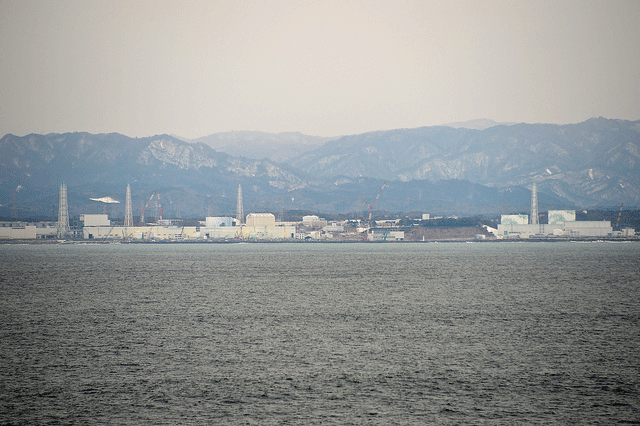
Fukushima nuclear power plant (Photo: raneko, Flickr Creative Commons 2.0)
BONNER: This is an expense that should not be parachuted on to the purse of the American taxpayer. This should come from Tokyo Electric Power Company. It would be unfair to the taxpayers for the VA to shoulder the responsibility for taking care of these sailors, when these illnesses were caused by this for profit multi-trillion dollar company.
FITZGERALD: Charles Bonner has a tough road ahead. He has to prove medical causality and convince a US court that it has jurisdiction over a Japanese company with a just a small office in Washington, DC. But, he says, given the severity his clients’ illnesses, they have to win.
BONNER: These young people must be taken care of and their offspring must be taken care of and this has to go on for a hundred years because a lot of these active particles that were released have a half-life of hundreds of years.
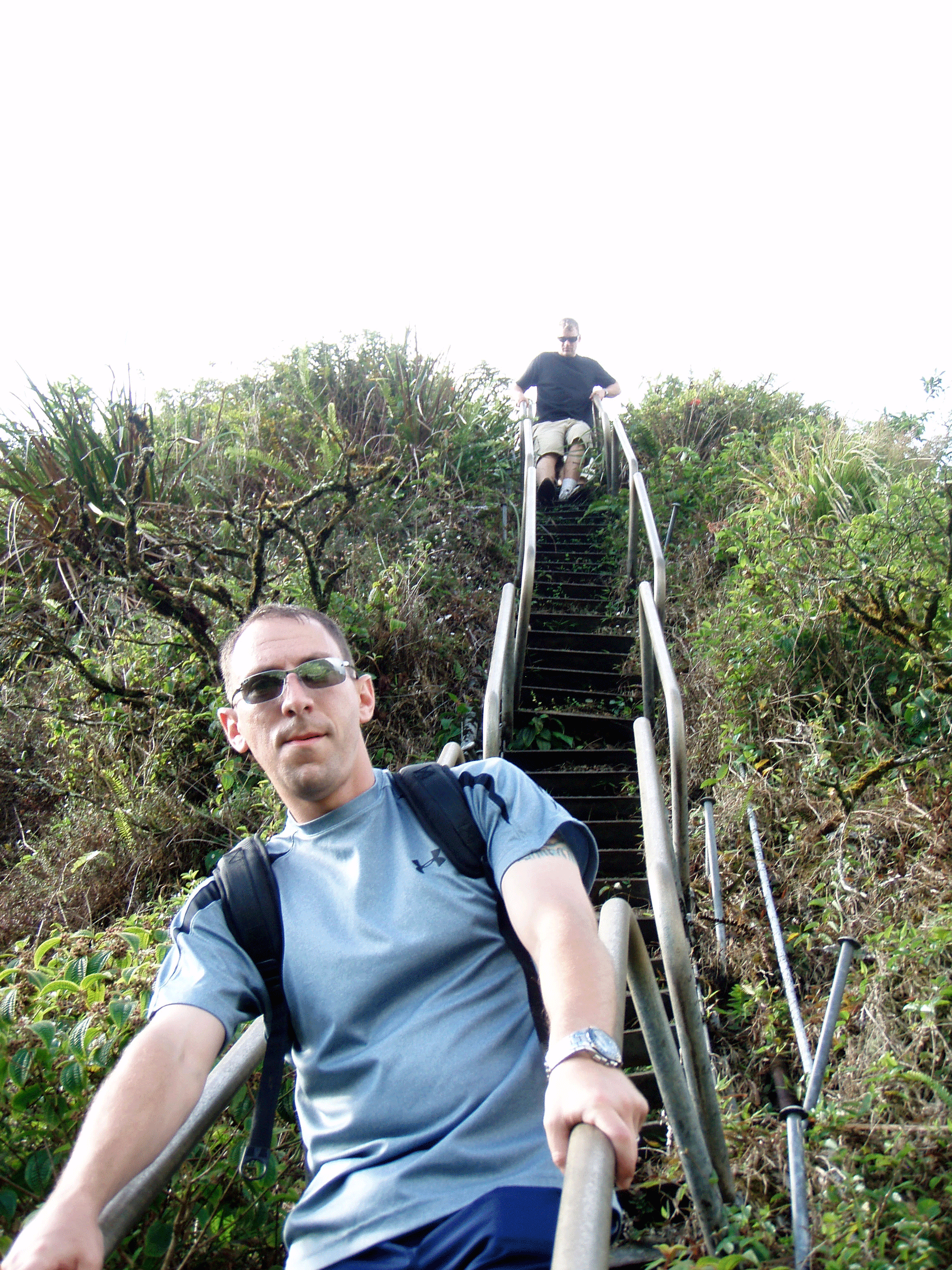
Lt. Steve Simmons before his exposure to nuclear contamination on the USS Reagan (photo: Steve Simmons)
FITZGERALD: As for Lieutenant Steve Simmons, he’d been in the Navy for over 16 years, and dreamed of becoming a captain one day.
SIMMONS: It absolutely is my life. I had actually had hopes of doing a 30 plus year career in the service. That was the goal.
FITZGERALD: Whatever happens with the lawsuit, it’s a goal he’ll find very hard to achieve now. For Living on Earth, I’m Emmett FitzGerald.
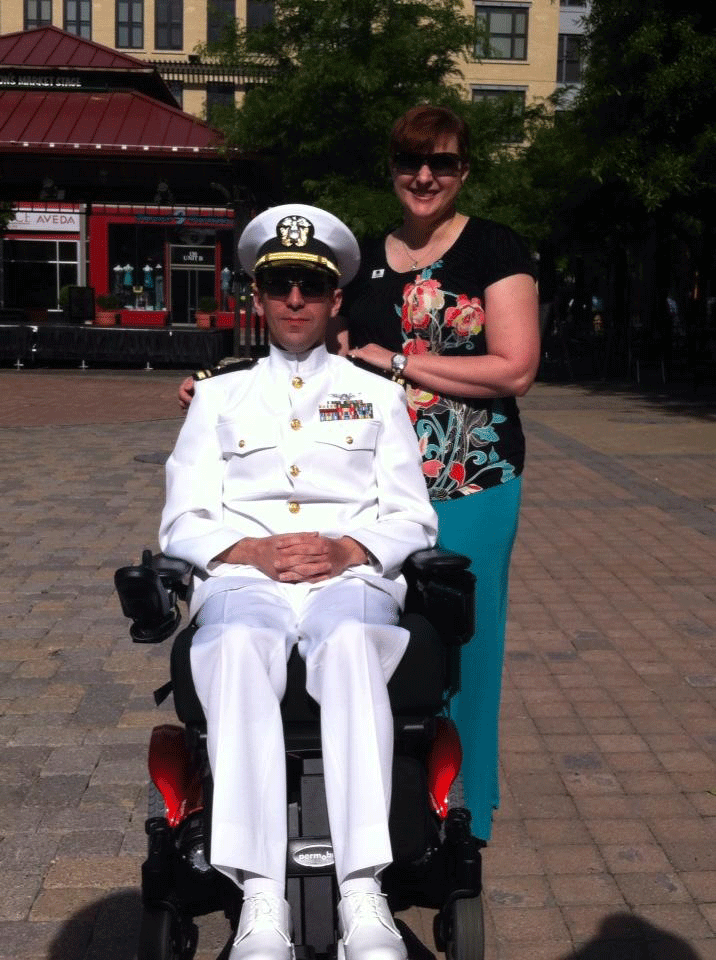
Lieutenant (jg) Steve Simmons after the Fukushima accident (photo: Steve Simmons)
CURWOOD: Neither the Navy nor TEPCO will comment directly on the lawsuit. Their general statements are on our website, LOE.org.
Related link:
Charles Bonner's law office
[MUSIC: Nguyen Le’ “Are You Experienced” from Purple – Celebrating Jimi Hendrix (ACT Records 2002)]
CURWOOD: Coming up - how natural gas fracking is leading to a bumper crop of plastic. Keep listening to Living on Earth.
[CUTAWAY MUSIC: Toots Thielemans: “Bluesette” from Bluesette (Solar Records Reissue 2012) (Toots announced his retirement this week at the age of 91)]
Petrochemical Boom on the Gulf Coast
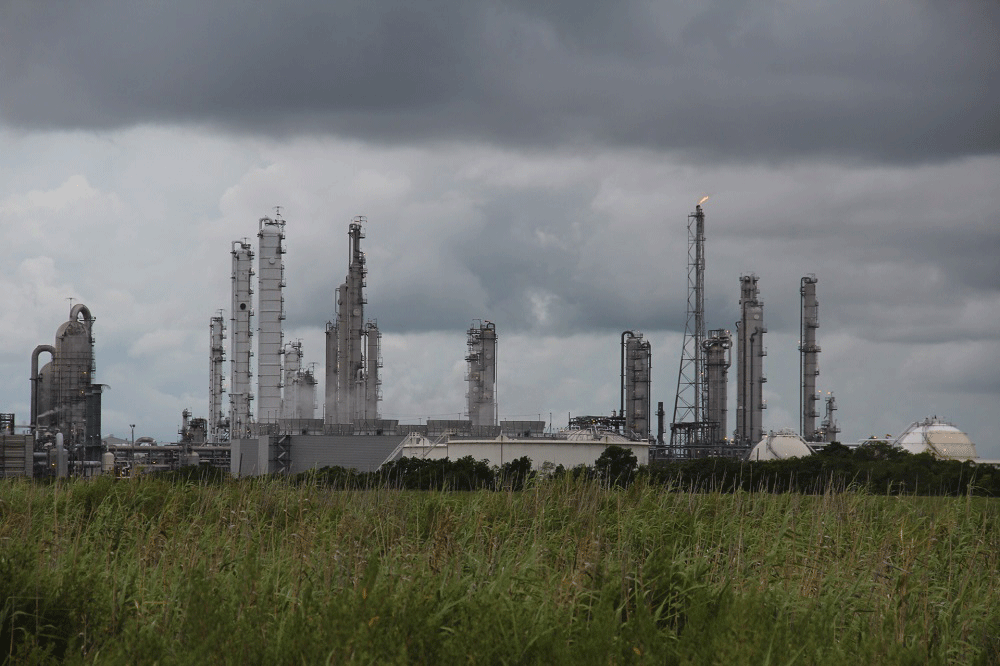
The BASF facility is part of an expansion in the petrochemical industry that promises $129 billion in new investments nationwide as a direct result of shale gas. (Photo: Reid R. Frazier)
CURWOOD: It's Living on Earth, I'm Steve Curwood. Fossil fuel is the lifeblood of modern transportation, and the source of those miraculous flexible, versatile, products - plastics. The natural gas boom is fueling a $100 billion dollar industrial resurgence in the petrochemical industrial complex on the Gulf Coast, and there are plants on the drawing boards elsewhere, including the Marcellus shale region of Pennsylvania. Reid Frazier of the public radio program the Allegheny Front reports from Port Arthur, Texas.
[FURNACE BURNING]
FRAZIER: Standing beneath what looks like an enormous HVAC system, Andy Miller points to a large metal box above him. A furnace burns at 2,000 degrees Fahrenheit inside the box.
MILLER: If you look up into this peep hole, you’ll be able to see some of the firing that goes on within a furnace.
FRAZIER: I look up into a hole the size of a quarter. There’s an orange glow coming from inside.
MILLER: But as you can see, this is where we actually crack the material into the products we desire.
FRAZIER: Miller is a unit manager for BASF at the company’s plant in Port Arthur, Texas. The plant here makes ethylene – this is like the granddaddy of all plastic, and many chemicals as well. You know that milk jug you’ve got in your fridge? Or the antifreeze in your car? All of it started its life in a place like this.
MILLER: This is where we start to build the building blocks to make those products.
FRAZIER: The plant was built 15 years ago to process crude oil into ethylene. But it recently underwent a facelift. It added some new equipment. Plant manager Greg Masica points me to some of it.
MASICA: What you see over here with this whole unit is a vaporizer.
FRAZIER: The vaporizer takes ethane - a key component of natural gas, and readies it for processing. The cracker heats the ethane up so hot that it cracks – literally. The molecular bonds holding it together, that have actually held it together for eons, break apart and form into ethylene.
When the plant was built, oil was the preferred raw material for the plant - natural gas was too expensive. But that changed a couple of years ago, thanks to a drilling boom brought on by fracking. Once $12 per thousand cubic feet, the price of natural gas has dropped and it’s now between $3 and $4.
As a result, chemical plants around the Gulf are expanding, or like BASF switching to natural gas. Shell’s proposed ethane cracker in Beaver County, in Western Pennsylvania, is one of seven brand new ethane crackers planned for the United States. That plant would take ethane from the Marcellus shale and convert it to ethylene. And other plastic units could be built alongside it. Industry experts all agree - fracking is good news for the American chemical industry.
CHANG: It is a huge deal. It’s a great amount of expansion, all based on the premise that you’re going to have these low-cost natural gas feedstocks for some time.
FRAZIER: Joe Chang is global editor of ICIS Chemical Business, a trade publication. Chang estimates the industry will expand in the U.S. by a whopping 38 percent in the next decade.
CHANG: It really has changed everything for the U.S. chemical sector and increased their prospects on a global basis.
FRAZIER: Almost overnight, America has become one of the cheapest places in the world to make plastic. That has the petrochemical industry here giddy. It’s planned over $100 billion in investments and is predicting a big jobs impact. But few of these jobs will actually occur at the plants themselves. After all, a new plant has a lot of automation, and only needs a few hundred workers to run it. But there are lots of other jobs that are created outside of the plant itself.
[SOUNDS OF GARAGE]
A few miles from the BASF plant, workers at DeBusk Services Group take a break between service calls. Randall Delahoussaye is the safety director here. He said the Port Arthur region suffered after the BP oil spill cooled off drilling in the Gulf. But drilling’s coming back, and expanding petrochemical plants have kept his shop and the local economy humming.
DELAHOUSSAYE: There’s a whole lot more motels in the area, the businesses stay packed, so the area around here’s been booming pretty good.
FRAZIER: His company uses industrial pressure washers to clean out pipes at big chemical plants and refineries. More plants, and more units mean more work for his crew of 50 or so.
DELAHOUSSAYE: As they put in more exchangers, more towers, it’s just more things to break. To go in and clean.
FRAZIER: The expansion of chemical plants in the Gulf is good news for the economy. But it’s happening in a region where the industry has had a mixed environmental record. Port Arthur is an oil town, and the city is ringed with a dozen industrial plants and refineries. The city used to fall short of federal air quality standards. But it’s met those standards the past eight years, because companies have cut down their emissions, and new plants have to demonstrate they’ll use tighter pollution controls before they’re allowed to build.
But the plants in Port Arthur still release nearly four million pounds of hazardous chemicals into the air every year, according to the EPA. That has some who live near the plants worried the air is bad for them. Jason Warrior is 28. He lives in Carver Terrace, a public housing project in the city’s predominantly black west side.
WARRIOR: This is an asthma pump my daughter right here uses.
FRAZIER: What’s your name sweetheart?
DAUGHTER: Makayla.
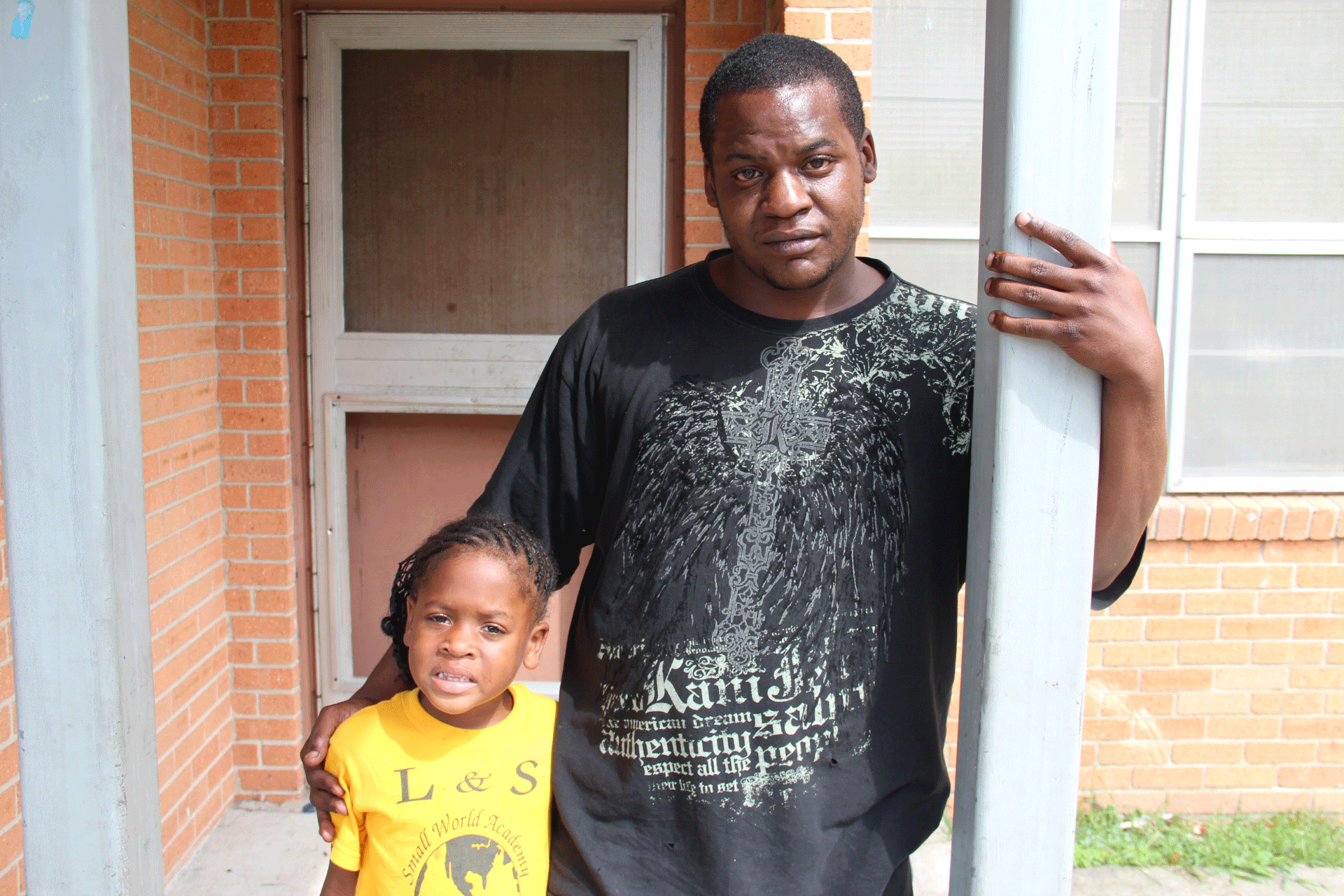
Jason Warrior and his 6-year-old daughter, Makayla both suffered from asthma since moving to Carver Terrace. (Photo: Reid R. Frazier)
FRAZIER: Makayla, who is six, uses the pump twice a week.
The neighborhood is near several chemical plants and the biggest refinery in the country. The EPA says the air quality here is good, but a door-to-door survey, conducted by a local community group a few years ago found that one in four households here has a child with asthma.
Warrior moved here three years ago to look for work in one of the plants, but hasn’t been able to find any so far. Both he and six-year-old Makayla got asthma when they moved here. These apartments are slated to be torn down. Some have mold inside, which can also exacerbate breathing problems. Warrior doesn’t know what’s caused his asthma, but he thinks the dark smoke he sometimes sees coming out of the plants may have something to do with it.
The smoke comes during unplanned events - like a power outage - when a unit is forced to burn off chemicals and fuel for safety reasons. According to state records, smaller events can happen on a nearly weekly basis here, according to state records. Sometimes, Warrior says, the flares at the plants light up the streets in the middle of the night.
WARRIOR: Probably like 2, 3 in the morning - something like that? They start burning them off. You’ll see the whole apartment building around here just light up.

Royal Dutch Shell Company plans to build the first petrochemical plant in Appalachia. It would be located in Monaca, Beaver Country, PA. (Photo: Bigstock Photo)
FRAZIER: It’s a sight that means jobs, and work for many in this community. With new plants in the works, it’s a sight that many along the Gulf - and possibly in Pennsylvania - will be seeing more of in the future.
CURWOOD: Reid's story comes to us courtesy of the public radio program the Allegheny Front; with support from the Fund for Investigative Journalism.
Related link:
Shale Gas Fuels Chemical Industry
BPA-Free Does Not Always Mean Safe

BPA has been banned from children’s products like sippy cups and bottles but some plastics used to replace BPA were also found to contain dangerous estrogenic chemicals. (bigstockphoto.com)
CURWOOD: Along with the environmental costs of manufacturing plastics, there is another set of risks. Though those numbers on the bottom tell you what can be recycled, plastic waste now litters the earth and seas, and what once seemed an inert material can sometimes affect human health. The widely used ingredient bisphenol A, BPA, has been shown to affect the hormone system by mimicking estrogen.
Now it's widely banned in baby bottles and children's sippy cups. Firms have created BPA-free alternatives - products like Tritan - but recent research suggests that the replacements and many other plastics are no safer. Mariah Blake, a reporter with Mother Jones, has investigated just what's in those plastics. She says there was certainly reason to get rid of Bisphenol-A.
BLAKE: The health hazards of BPA are well documented and they are numerous. So they range from breast and prostate cancer to diabetes to heart disease to increased aggression and Attention Deficit Disorder. The list is pretty long and surprisingly diverse. There is no longer any legitimate scientific debate about the health effects of BPA.
CURWOOD: Now, the chemical industry got rid of BPA from some products, but it’s still fairly widely used, I understand.
BLAKE: Yes, so BPA is still ubiquitous in plastics. There is a kind of plastic called polycarbonate that contains BPA, and it’s still used for many things. BPA is also present in the lining of tin cans, and in cash register receipts. So if you receive a cash register receipt and it has a sort of slippery quality, that’s because it has a BPA coating on it.
CURWOOD: So there were plastics that were put together to replace BPA so that other things could be used for baby bottles and sippy cups and water containers, so what kind of testing has been done on these other plastics?
BLAKE: The way it works in the United States, most chemicals have never been tested for safety, so there’s more than 80,000 chemicals that are used in commerce in the United States, and only a very tiny fraction of those have been tested for safety. And chemicals are generally presumed safe until proven otherwise. So these plastics that are being used to replace polycarbonate - the BPA laden plastic - we don’t necessarily know much about their safety.
CURWOOD: Now you document the research and testing done by, well, shall I call them a colorful cast of characters?
BLAKE: I think that’s a fair characterization, yes.
CURWOOD: Now, they’re trying to solve the mystery of the effects of these plastics. One of the colorful people in this is a gentleman named Bittner. Tell me a little bit about him.
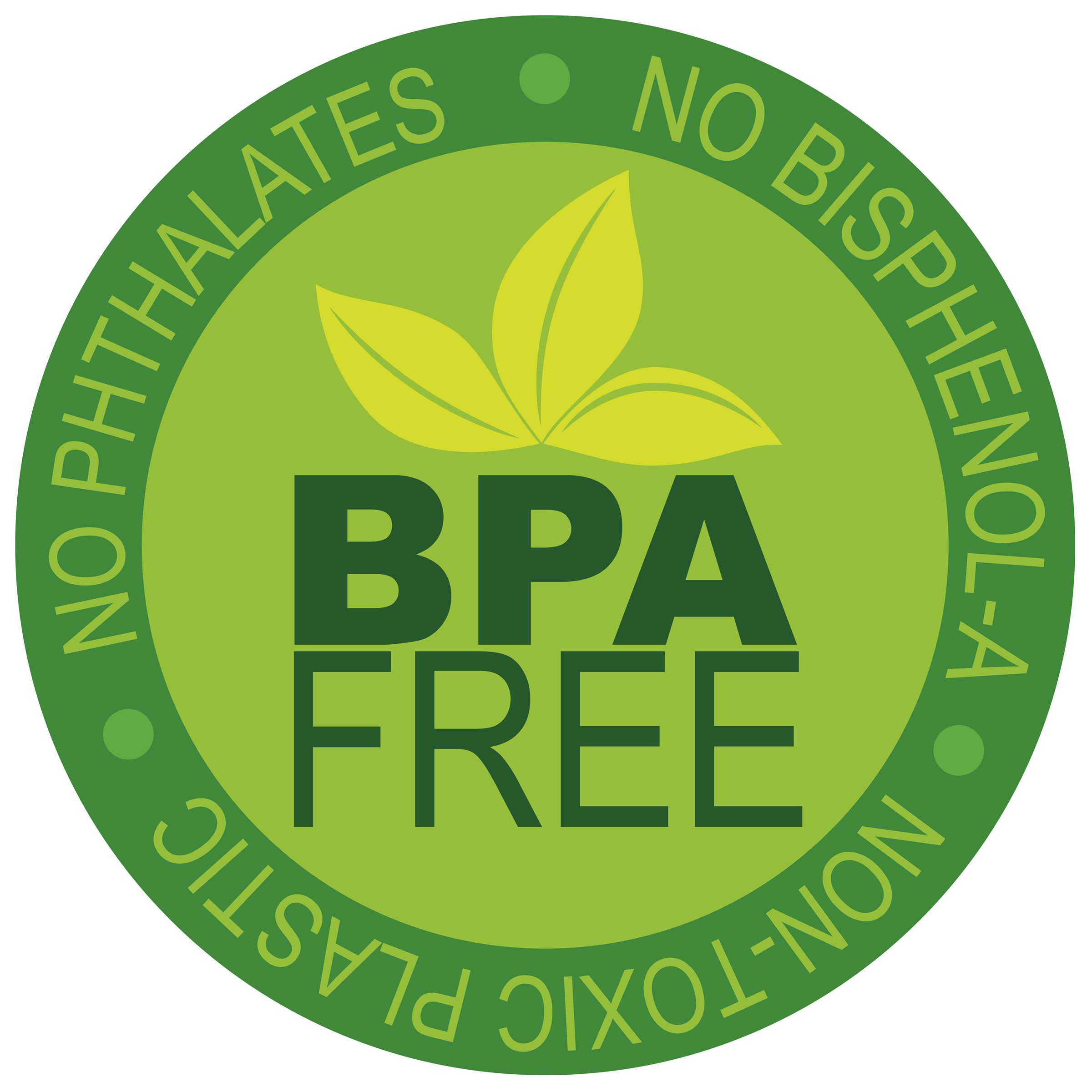
BPA free does not necessarily mean that a plastic product is also free of any estrogenic chemicals. (bigstockphoto.com)
BLAKE: George Bittner is a University of Texas professor who launched a private company called CertiChem, and CertiChem tests products for estrogenic activity. It’s hard to know which ones do and do not have these chemicals in them. You cannot tell by the numbers stamped on the bottom of them, so traditionally people have believed that, plastics, for example, that have the number one stamped on the bottom of them - that’s PET or PETE - were safe. Now, in Bittner’s tests, 75 percent of these tested positive for estrogenic activity. That doesn’t mean that all of them have estrogenic activity, but we can’t tell without actually testing them which ones do and which ones don’t. So it really creates a quandary for consumers.
CURWOOD: Now, what has been the response of the manufacturers of plastic products to these tests being done by independent lab researchers?
BLAKE: Well, the response has been three-pronged by the industry. Firstly, they have attempted to discredit the scientists who are doing this research. Secondly, they have attempted to suppress the evidence. And thirdly, they have generated their own biased research, which shows that these products actually are safe.
CURWOOD: Give me some details on that please.
BLAKE: OK. For example, Eastman Chemical, which is the company that produces Tritan, which is a product that is marketed as being free of all estrogenic activity, but which Bittner’s tests found actually is more estrogenic than polycarbonate, they essentially launched a character assassination campaign against Bittner where they told their corporate customers that Bittner was shady. They claimed that his tests had been rejected by the EPA when, in fact, they hadn’t. They called his business practices into question, and they also made the case that his testing methods were not reliable. Now the method that he uses involves a line of breast cancer cells that has been used to screen for estrogenic activity for decades. It is the most commonly used, or one of the more commonly used methods, and it is considered to be one of the most sensitive methods.
CURWOOD: And the final point?
BLAKE: The final point - Eastman Chemical performed a variety of testing and, in fact, the initial tests actually found that their product was estrogenic. They ran a test using computer modeling, which predicts based on the chemical structure whether a chemical is estrogenic. And that test found that one of the ingredients in Tritan is more estrogenic than BPA. So what they did was perform animal tests, not on Tritan itself, but on certain ingredients, and they didn’t include TPP, which was the substance that had tested positive for estrogenic activity. The tests are designed, essentially, not to find estrogenic activity.
The clearest example of that is that they often use a type of rat that is called the Charles River Sprague Dawley rat. This rat is known to be insensitive to estrogen, so it can withstand doses of estrogen that are about 100 times higher than a human female with no response. What this means is the industry is testing a chemical that mimics estrogen on an animal that does not respond to estrogen. They published this study and used it to try to discredit the findings by George Bittner, which had found that Tritan was, in fact, estrogenic.
CURWOOD: Now, in your article, you write about PR companies involved in efforts to discredit studies showing tobacco and second hand smoke are dangerous are now helping plastics companies. Tell me more about that please.
BLAKE: Yes, it’s very interesting. Not only has the industry adopted the tactics of Big Tobacco, but, in many cases, they’re relying on the same consultants. So many of the same scientists who were involved in doing tobacco industry research are now doing chemical industry-funded research on chemicals like BPA. And just like Big Tobacco industry-funded studies generally did not find that smoking or second-hand smoke was harmful, these studies are not finding that BPA and similar chemicals are harmful. And this again goes back to the way our regulatory system works. So, because chemicals are assumed safe until proven otherwise, all an industry has to do to block regulation is to sow doubt about the science tying a certain chemical or product to disease. And this is something that has been well-documented. So the industry has discovered that it’s much easier and more effective to debate the science than debate the policy. So they continually sow doubt about the science.
CURWOOD: What about the federal government? The aim of the federal government is to protect public health. What’s it doing in this case?

Plastic products are ubiquitous in modern life (photo: bigstockphoto.com)
BLAKE: In this case, the federal government has really done very little. It is true that BPA is now banned in children’s products, but this is actually because consumers started demanding BPA-free products, and the industry eventually quit using BPA in products for children, and eventually asked the FDA to ban it as a way of reassuring consumers that children’s products were safe. In many ways, regulators are captive to industry, so in the case of BPA, for example, in 2008 it came to light that the FDA was relying on industry lobbyists to write its evaluation of BPA, and that its finding that BPA was safe was based almost entirely on two industry-funded studies, one of which as fatally flawed.
CURWOOD: What do you feel is the message that the public should take home from your investigation?
BLAKE: By educating themselves, and by demanding products that are free of all estrogenic activity, consumers can potentially have an impact. I think it’s important for people to be aware that many of the chemicals that are used in the products they use every day have not been tested for safety. We know that these chemicals have some sort of an effect, and we know that many plastics probably contain these chemicals, but we don’t know what exactly the affects will be. One of my sources put it this way, it’s like an “unplanned science experiment we’re doing on our families every day”. I would say until the science is clearer, people may want to consider limiting their exposure to plastics and using natural materials instead. So, for example, I have a three-year-old son. I give him a stainless steel sippy cup which has a nozzle that is not made from plastic. And there’s glass replacements for tupperware. There are various products people can use in lieu of plastic.
CURWOOD: That stainless steel sippy cup for your son, that makes an awful lot of racket when he throws it across the room.
BLAKE: [LAUGHS] Yes, I mean it’s a...there are always tradeoffs. In this case, it’s worth it for me. Having a three-year-old is something that involves a lot of noise anyway, so it doesn’t significantly increase the amount of noise in my house.
CURWOOD: Mariah Blake is a reporter with Mother Jones magazine and the investigator who wrote The Scary New Evidence on BPA-Free Plastics. Thanks for taking the time with us today, Mariah.
BLAKE: Thank you so much for having me.
CURWOOD: And there's a link to Mariah Blake's story at our website LOE.org where you can also find a statement from Eastman Chemical. It reads in part and I quote “independent third-party labs tested Tritan and have proven that it is free of estrogenic activity.”
We note that court documents relied on by Ms. Blake for her story include internal Eastman communications that show the company took pains to suppress evidence that the product contains estrogenic ingredients.
RESPONSE FROM EASTMAN CHEMICAL
Eastman stands behind its products. To ensure the safety of TritanTM, a BPA-free plastic, we used testing methods regarded as “gold standards” by the scientific community. In fact, we have gone above and beyond government and industry testing requirements. Independent third-party labs tested Tritan and have proven that it is free of estrogenic activity. Eastman does not fund independent third-party labs. It hires labs to provide time and expert services to arrive at an independent result, not for a particular conclusion.
Statements that all plastics display estrogenic activity are simply not true. Eastman Tritan does not display estrogenic activity, as supported by the science and testing presented on our Safety Testing page and further detailed in a downloadable white paper.
Eastman has gone above and beyond government and industry testing requirements to prove Tritan is free of estrogenic activity. The company used independent third-party labs and accredited universities to test Tritan and they’ve proven it’s free of estrogenic activity.
WIL Research Laboratories performed its testing in accordance with the Organisation for Economic Co-operation and Development (OECD), which develops test methods and standards. This includes determining the correct strain of rat to be used for testing, including those tests conducted with Tritan.
Eastman made information about the testing of Tritan publically available to ensure access to it.
PlastiPure and CertiChem used a single, non-definitive screening test called the MCF-7 test. It is widely accepted and acknowledged that this test is usually considered an initial screening test and has not been validated by the National Toxicology Program's Interagency Coordinating Committee on the Validation of Alternative Methods and the U.S. Environmental Protection Agency (EPA) for use in its Endocrine Disruptor Screening Program for the purpose of identifying substances with estrogenic activity (EA).
Eastman filed a lawsuit against PlastiPure and its sister company CertiChem to prevent these companies from publicizing false and misleading information about Tritan that were based on poor science and used to promote their businesses and not to further a scientific debate as they claimed. These two companies set out to financially benefit from consumer concern by providing false and misleading information. In fact, Dr. Bittner and his colleagues testified at the trial last July that they had no evidence to support a statement that Tritan could be harmful to humans or animals. A jury was convinced by both scientific evidence and expert testimony and Eastman won the case, which resulted in the companies being ordered to stop making additional misrepresentations about Tritan.
The lawsuit was never intended to stop the companies, or any other organization, from publishing test results or to squelch scientific discussion.
When anyone chooses a product made with Eastman Tritan, they need to know that Eastman remains confident in its testing and the safety of our products.
For more information about Tritan, we ask that you visit TritanSafe.com.
Related links:
- Mother Jones- The Scary New Evidence On BPA-Free Plastics
- Mariah Blake
[MUSIC: Kris Bowers “Vice’s And Virtues” from Heroes And Misfits (Concord Music 2014)]
CURWOOD: Coming up...a feathered river across the sky; the amazing and extinct spectacle of the passenger pigeon. That's just ahead on Living on Earth. Stay tuned.
ANNOUNCER: Funding for Living on Earth comes from the Grantham Foundation for the protection of the environment. Supporting strategic communications and collaboration in solving the world’s most pressing environmental problems. The Kendeda Fund, furthering the values that contribute to a healthy planet, and Gilman Ordway for coverage of conservation and environmental change. This is PRI, Public Radio International.
[CUTAWAY MUSIC: Dave Brubeck: “Let’s Fall In Love” from The Very Best Of Dave Brubeck: The Fantasy Era 1949 – 1953 (Fantasy Records 2012) We note the passing of Dave’s Wife and long time companion Iola Brubeck]
Beyond the Headlines:
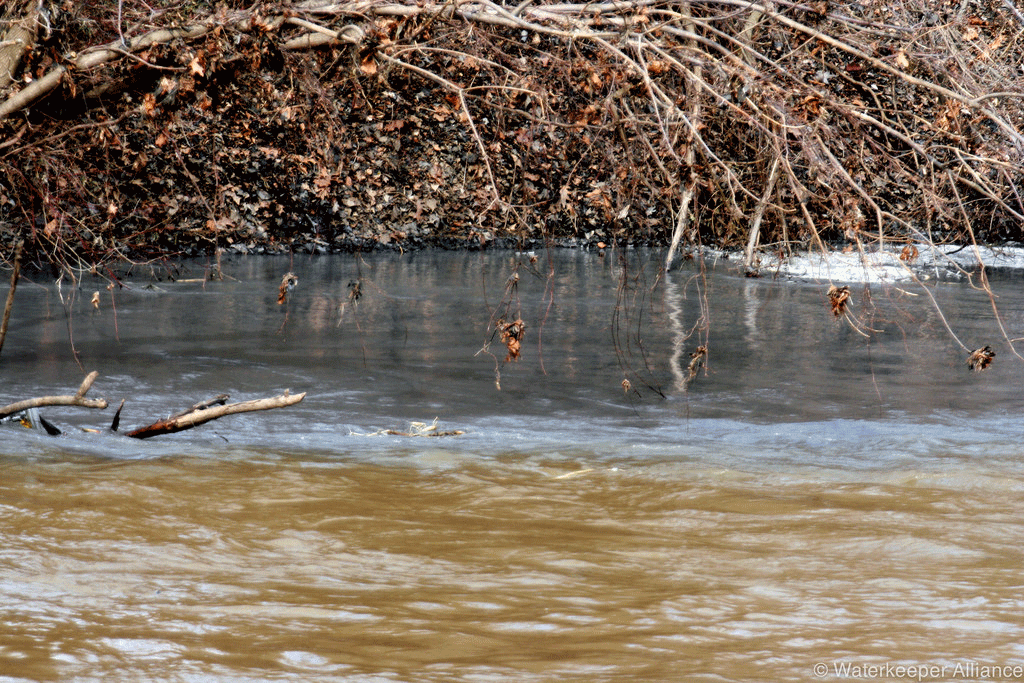
Coal ash in the Dan River (photo: Rick Dove/Waterkeeper Alliance, CreativeCommons 2.0)
CURWOOD: It's Living on Earth, I'm Steve Curwood. We head beyond the headlines now, with Peter Dykstra, the publisher of DailyClimate.org and Environmental Health News - that's EHN.org. He's on the line from Conyers, Georgia. Hi there, Peter.
DYKSTRA: Hi Steve, this week we're going to take a look at a few different things on the theme of people’s ability to fool other people.
CURWOOD: Ah ha, hustles. What’s the first one?
DYKSTRA: Well, we picked up this story from Midwest Energy News. You know, when there’s a huge coal ash spill, like the one in North Carolina last month, we’re reminded that coal ash is hard to store, that there’s a lot of it, it’s dangerous to spill and it can be loaded with toxic substances. So what do they do with some of the Midwestern coal power plants? They give away coal ash to local governments.
CURWOOD: So you’re saying that some local governments gladly take what no one else would want? What’s the deal?
DYKSTRA: Local highway departments in the Midwest use the coal ash to spread it on icy winter roads for better traction.
CURWOOD: But hang on...the icy roads melt, and the coal ash gets carried into waterways then.
DYKSTRA: Bingo. Coal burning power plants in the Midwest give away an estimated quarter-million tons of coal ash every year. That’s at least three times the size of the big spill in North Carolina. And for that spill, Duke Energy is facing a billion-dollar cleanup tab. While instead in the Midwest, you haul the coal ash away and you spill it for free.
CURWOOD: But you just told us the stuff is toxic. What happens to the water quality?
DYKSTRA: There are varying levels known to exist of cadmium, chromium and other heavy metals that are toxics. We don’t know exactly what the impacts are; the EPA has come up with a new testing method. There was one very reassured public works director in Iowa who’s quoted in the story, sounded a little bit gullible, and what he said was, “They wouldn’t give it to us if it wasn’t safe.”
CURWOOD: Oh, Peter, I’m almost afraid to ask about the next one you’ve got.
DYKSTRA: Well, this one comes from Beth Daley, and Beth is a longtime reporter for the Boston Globe. She now works at the New England Center for Investigative Reporting. She took a deep dive into all sorts of public records relating to federal flood insurance payments, and she focused on one house. It’s a house on the beach that common sense would tell you has no business being where it is. It has a beautiful ocean view, and the problem is every few years the ocean comes to visit the house and ends up in the living room.
There are nine separate grants that she found, or federally subsidized insurance claims. They’ve literally propped up this house in Scituate, Mass. south of Boston. It’s gotten at least three-quarters of a million in taxpayer bailouts for this home that worth a little more than a million. And there are hundreds of homes like it, and the FEMA program that supports flood insurance is $24 billion in debt.
CURWOOD: I guess it’s more than living rooms that are getting soaked here. I thought Congress moved to overhaul this program a couple of years ago, but it’s recently backed off?
DYKSTRA: Uh, that’s correct, there were some coastal homeowners that saw their insurance rates shoot way off the charts to levels that were deemed to be truly unfair, so Congress made some fixes, but that rolled back the program and the bottom line is that taxpayers are still being soaked to subsidize flood insurance in places where regular commercial insurers simply refuse to go.
CURWOOD: What about our weekly dive into history?
DYKSTRA: Well, here’s another one on the theme of people fooling other people, but we have to go back 510 years to find it, the year 1504. It was Christopher Columbus’s fourth journey to the New World. Columbus didn’t always slaughter and enslave the Native people he found, in this particular case he just swindled them. His expedition was marooned in Jamaica, they were nearly out of food, and then one day the native chiefs started to refuse to feed them. Columbus told them that the Gods would show their anger that very night, at least that’s how the story goes. And Columbus knew there would be a lunar eclipse happening that night, and when the moon turned blood-red and then disappeared, he had completely punked the natives and the crew got to eat.
CURWOOD: So it carried on with native folks. I’m thinking about the $24 worth of beads that the Dutch used to purchase Manhattan.
DYKSTRA: Yes, that one worked out pretty well in the real estate market too.
CURWOOD: Peter Dykstra is the publisher of EHN.org and DailyClimate.org. There are links to these stories at our website LOE.org. Thanks, Peter.
DYKSTRA: Thanks a lot, Steve. We'll talk to you soon.
Related links:
- Read Beth Daley’s story here
- Read about free Midwest coal ash here
- Columbus Eclipse Legend
A Feathered River Across the Sky
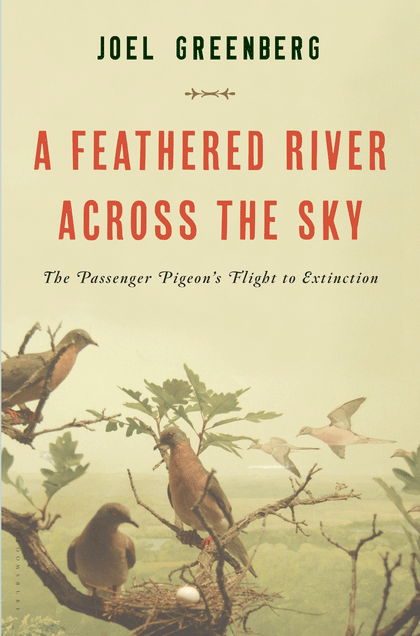
Cover photo
CURWOOD: Well, the New World offered many other wonders besides gullible Native Americans to the first settlers. Then up to 40 percent of the continent’s birds were passenger pigeons, that travelled in flocks so massive they blocked out the sun for hours, sometimes for days. Yet the species was gone within a couple of centuries, and the very last passenger pigeon, Martha, died in the Cincinnati zoo in 1914. Joel Greenberg is the author of “A Feathered River Across the Sky, the Passenger Pigeon’s Flight To Extinction”, and he joins us now from Chicago. Welcome to Living on Earth, Joel.
GREENBERG: Well, thank you very much, Steve, it's an honor to be on your show.
CURWOOD: First of all, why did they call them passenger pigeons?
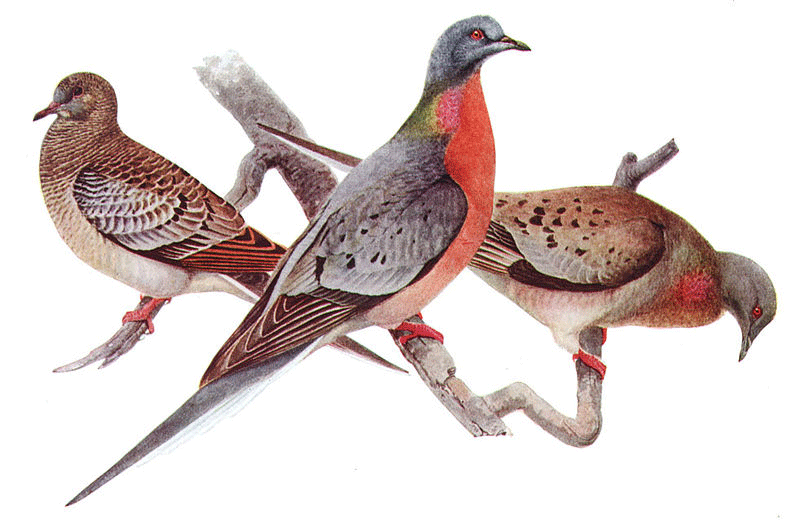
Juvenile (left), male (center), female (right), by Louis Agassiz Fuertes (public domain image)
GREENBERG: Well, it was because they were moving all the time in search of food, so they would be here today, gone tomorrow. They were birds of passage.
CURWOOD: Uh huh. What did the passenger pigeon look like?
GREENBERG: Passenger pigeons look a lot like morning doves. They were more brightly colored. They were larger by maybe one-and-a-half times. Turns out though that they’re most related to another group of pigeons, North American pigeons, the best known of which is the Band-tailed pigeon of the west.
CURWOOD: So the passenger pigeon is its own genus. It’s not even just a species.
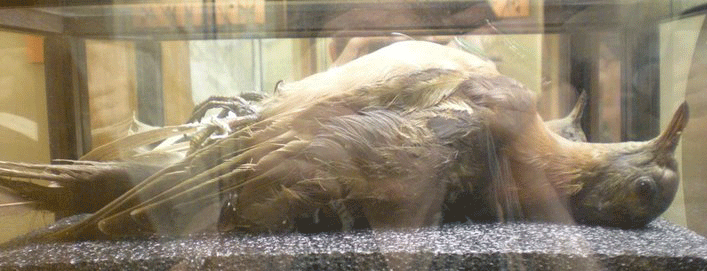
The last known wild passenger pigeon, shot by a boy in Ohio in 1900. Cincinnati Zoo. (Sarah Stierch, Wikipedia)
GREENBERG: That is correct. There were three things about the passenger pigeon that made it unlike any other bird that human beings have ever known. One, the huge population, almost certainly in the billions - the most abundant bird in North America if not the world. Secondly, that population was not evenly spread over the landscape. They would aggregate in huge, huge numbers, perhaps the largest flight ever reported was from 1860 near Toronto. Modern scientists have made some assumptions, and they believe that depending on how fast the birds were flying, there were anywhere between two billion and 3.7 billion birds. And third, despite that abundance, by 1900, just 40 years later, the bird was, for all intents and purposes, gone from the wild. 14 years after that, the last bird died in the zoo. So the rapidity with which deliberate human action wiped out a species of that population size is unprecedented.
CURWOOD: It’s hard to imagine how an animal numbering in the billions just completely disappeared over the space of less than 50 years. What exactly happened?
GREENBERG: We happened to them. They were just exploited mercilessly. With the introduction of railroads and the telegraph in the 1840s, that meant that if you were close to a railroad station, you could ship barrels of them to major urban centers, and of course, in the mid-to-late 1800s cities like New York and Chicago were growing - dramatically - so this provided cheap food. Secondly, the telegraph meant that wherever the bird showed up, that information could be disseminated very quickly. The telegraph operators were specifically instructed to share this information. There was a group of men, anywhere from 600 to 3,000, who did nothing but chase these birds wherever they were, so if they nested in Pennsylvania, they’d spend May in Pennsylvania. Then the birds would migrate away from the nesting...they’re done, they roost in Indiana. They would go hurrying to Indiana and just follow the birds. And then you have the locals who also were killing the birds for their own use as well as a way to augment their income. So these birds were being relentlessly targeted. As people went into the nesting colonies with the kind of shooting and disturbance, the birds just abandoned nesting altogether and would just say, “OK, the heck with this, I’m just leaving.” And then the collapse was rapid.
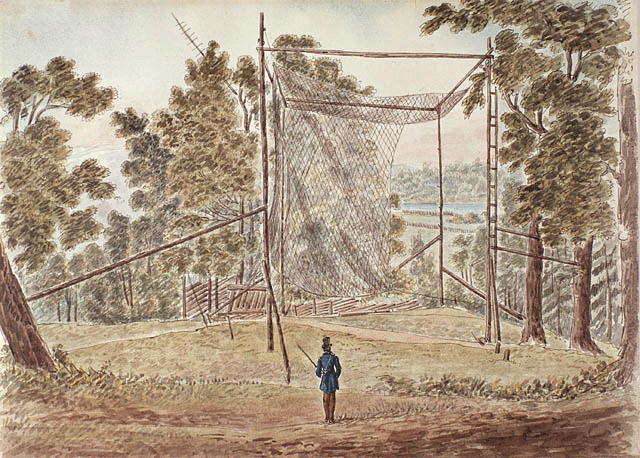
"Passenger Pigeon Net, St. Anne's, Lower Canada,” Watercolour and pen and black and brown ink on wove paper. September 20, 1829 (image: James Pattison Cockburn, public domain)
CURWOOD: What were these passenger pigeon harvests like?
GREENBERG: There were two principle ways the birds were killed. They were shot, and they were netted. The nettings were pretty elaborate affairs. But in order to attract the birds, they used two kinds of live passenger pigeon decoys. The first were known as flyers. They were tethered, and so when a flock of wild pigeons flew over, these birds were let go as the wild birds turned to take another look, they would pull in the flyers and they would then use what was known as a stool pigeon, that’s how about the term came about, one who betrays one’s own kind. Stool pigeons were attached to a stool, which was at the end of a pole. And so, the wild birds see this bird peacefully feeding, they would come down, and sometimes hundreds of birds would be caught in a single release of the net. And if there were too many birds, then you had a problem because enough of them could raise the net just a bit, so some birds could escape. So the hunters left their blinds, threw themselves onto the net to weigh it down, so they’d reach in and they’d chomp down with their jaws on the back of the pigeon’s neck. One guy complained he’d bit so many pigeons his teeth actually got loose.
CURWOOD: How tasty were these birds?
GREENBERG: Well, the literature varies, different people had different opinions. Wild birds, adults, some people said were pretty stringy, others liked them. Clearly the squabs, the babies which were fat and tender, those were the birds that were most coveted.
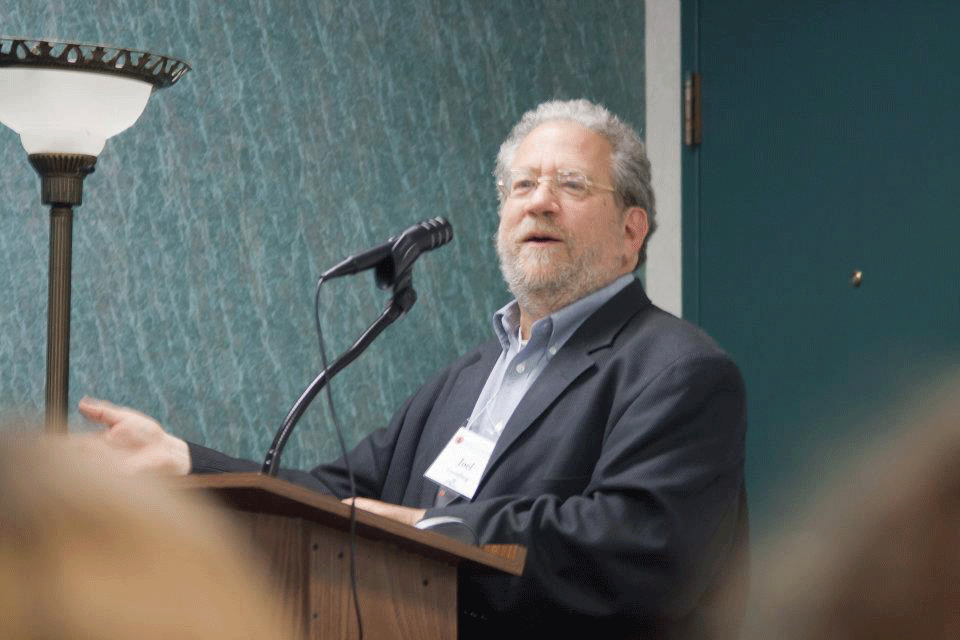
Author Joel Greenberg (photo: JoelGreenberg.com)
CURWOOD: So in the late 1800s some people begin to notice the passenger pigeons were becoming scarce. How did they explain what was happening?
GREENBERG: Different people reacted to that differently. There was an industry, and people who had a financial interest in maintaining the taking of these birds made up things like, “oh, don’t worry, the birds lay multiple eggs and they nest many times during the year.” Well, the fact is the bird only laid one egg, and they only nested once a year. The last real gathering of any size at all were a few million birds in Wisconsin and Pennsylvania in 1882 so people would say, see, there’s a big flock in Wisconsin, so don’t worry. When people are confronted with inconvenient truths, one approach is to deny it.
There were even more bizarre responses. One person wrote that the birds had all moved to Colombia, South America, lived in the jungles and changed their appearance so no one could recognize them. No, no, they moved to Arizona in the desert, like Americans seeking freedom have always done, they moved west. Once the birds were extinct, one guy was a pigeon hunter and wrote articles defending the industry. When the birds were gone, he wrote an article and he said, “yup, the birds are gone and, man, I don’t have any idea at all how this happened.”
CURWOOD: Joel, this is such a dark story. Why explore this now 100 years later? Why not just let this rest?
GREENBERG: Well, there’s a couple of responses to that. It’s a powerful cautionary tale. It shows that no matter how common something is, and that could be water, it could be fuel, or it could be something alive. If we’re not good stewards, if we’re not careful, we can lose it. And so, this message, this lesson is important to us today. I mean, there’s an analogue I think is the closest, and that’s pelagic fishing - removing all living things using these factory ships with their nets, depleting shark and tuna populations for the same reason the pigeon was wiped out.
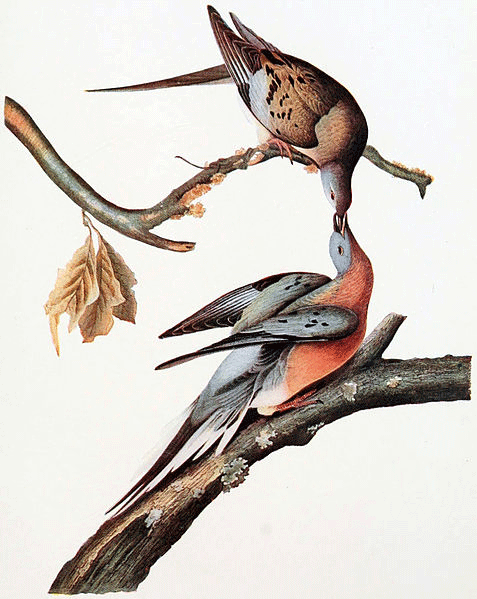
Passenger Pigeon illustration from 1907 (image: John James Audubon)
There’s no sovereign that can say, “don’t take more than a certain amount,” it’s going to require international cooperation, so I think the story bolsters international cooperation. So I think the story really bolsters the importance of conservation. And secondly, it affected 19th century culture in a way that we probably can’t appreciate today. It inspired James Fenimore Cooper. His first novel has a scene about passenger pigeons, and he sets up a conservation dilemma with different characters taking different perspectives. So, it moved people who saw this.
It still inspires people. I mean, the story is still powerful. And Steve, since 2010, I’m aware of four different novels where the pigeon is either an element of the plot or the setting for the story. So it still moves people in many ways. I think that why it’s relevant is we really have to be vigilant, and I think it behooves us, for those of us that care, you know, to live in a beautiful world that’s full of wonder and nature is vibrant, to do what we can to let the powers know that we care about this.
CURWOOD: Joel Greenberg‘s book is called “A Feathered River Across the Sky, the Passenger Pigeon’s Flight To Extinction”. Joel, thank you for taking this time with me today.
GREENBERG: Well, thank you so much, Steve. I really appreciate it.
Related links:
- "Martha: Last Of the Passenger Pigeons," written and performed by John Herald.
- Heinrich wrote the symphonic piece, The Columbiad, or Migration of American Wild Passenger Pigeons (1858).
[MUSIC: Third World “Jah Glory” from 96 Degrees In The Shade (Island Records 1977)]
Deer Miss

A lone buck (photo: bigstockphoto.com)
CURWOOD: The passenger pigeon is gone, and with it, perhaps the resilience of trees that depended on the birds to transport their seeds. Humans also wiped out the wolf in much of America, and in the East where there are still no wolves, the population of their natural prey, the white-tailed deer, has exploded. Collisions between deer and cars result in at least 200 human deaths a year and many millions in damages. Writer Mark Seth Lender had his own potentially fatal encounter.
LENDER: Heading North on 95, I glance across the median and the southbound traffic on the other side, toward the woods. There is an opening there where the granite spreads like two gnarled fingers. The gap between holds a small pond sleeping now beneath new ice dusted with fresh snow, a flat white space. The trees rimming the pond, and the scrub that pokes up in bent and broken spokes are bare, and all around the brown-gray of early spring. Only the oaks still have their leaves, like old clothes held at the throat against the cold.

Four white-tailed deer in winter (photo: bigstockphoto.com)
On the rim, is a white-tailed deer. She steps out onto the ice, deliberate but unsure. Like a child learning to walk. She is heavy, and alone. Easily, she could go around. Instead she is risking her life and the life inside her. The ice is thin. If she falls, even if she does not go through and drown, she’ll break a bone. Yet this is the way she has chosen.
Driving on I keep thinking about her. How unsure she was - she understood the danger. Why didn’t she go around, skirting the shore? What was there behind her in the woods, real, imagined, both, that sent her on this desperate course? Or was it habitual and blind determination? Or only, an error in judgment.
Hard to know.
Some minutes later, on my way back, there she is by the road. Now I can see just how heavy she really is. She sticks out sideways like an oversized load. At first I thought she was here to graze. Deer may do that if they are desperate enough and this time of year that’s exactly what they are, desperate. But the grass at the shoulder is either not to her liking, or glazed over with ice. Or maybe there is too much road salt. Grazing animals usually like that but for some reason she does not. What she does like is on across 4 breakdown lanes and 4 lanes of cars and trucks and most of them doing eighty. And I can see, telegraphed by where she looks and the way she stands that she is going to go and that nothing is going to stop her.
And just like her without thinking, I flip on my lights and lean on the horn and head straight towards her and she bolts - I think towards the woods - and a semi tucks in behind me and I cannot see her.

A lone buck (photo: bigstockphoto.com)
The following morning, southbound on the highway coming home, I see at the same place where the deer crossed the ice another set of her tracks heading back the way she came. And only then it occurs to me, what if at the shoulder she’d run the wrong way? Another day she may do just that. But for yesterday and for now -
She Lives. I Live. We live.
CURWOOD: That's writer Mark Seth Lender.
Related link:
Nature Photo Tours
[MUSIC: Caleb Quaye And The Faculty “As The Deer” from One Night In San Dimas (Potters Wheel Records 2008)]
CURWOOD: Living on Earth is produced by the World Media Foundation. Naomi Arenberg, Clairissa Baker, Bobby Bascomb, Emmett Fitzgerald, Helen Palmer, Catalina Pire-Schmidt, Adelaide Chen, James Curwood, and Jennifer Marquis all help to make our show. And today we bid a fond farewell to Gabriela Romanow, who helped to keep us in touch with you, our listeners. And special thanks to the studio of Portland, Maine. Jeff Turton is our technical director. Alison Lirish Dean composed our themes. You can find us anytime at LOE.org, and like us on our Facebook page - it’s PRI’s Living on Earth. And we tweet from @LivingOnEarth. I'm Steve Curwood. Thanks for listening.
ANNOUNCER 1: Funding for Living on Earth comes from the Grantham Foundation for the protection of the environment. Supporting strategic communications and collaboration in solving the world’s most pressing environmental problems. The Kendeda Fund, furthering the values that contribute to a healthy planet, and Gilman Ordway for coverage of conservation and environmental change. Living on Earth is also supported by a friend of Red Tomato, supplier of righteous fruits and vegetables from northeast family farms. www.redtomato.org. This is PRI, Public Radio International.
ANNOUNCER 2: PRI, Public Radio International.
Living on Earth wants to hear from you!
Living on Earth
62 Calef Highway, Suite 212
Lee, NH 03861
Telephone: 617-287-4121
E-mail: comments@loe.org
Newsletter [Click here]
Donate to Living on Earth!
Living on Earth is an independent media program and relies entirely on contributions from listeners and institutions supporting public service. Please donate now to preserve an independent environmental voice.
NewsletterLiving on Earth offers a weekly delivery of the show's rundown to your mailbox. Sign up for our newsletter today!
 Sailors For The Sea: Be the change you want to sea.
Sailors For The Sea: Be the change you want to sea.
 The Grantham Foundation for the Protection of the Environment: Committed to protecting and improving the health of the global environment.
The Grantham Foundation for the Protection of the Environment: Committed to protecting and improving the health of the global environment.
 Contribute to Living on Earth and receive, as our gift to you, an archival print of one of Mark Seth Lender's extraordinary wildlife photographs. Follow the link to see Mark's current collection of photographs.
Contribute to Living on Earth and receive, as our gift to you, an archival print of one of Mark Seth Lender's extraordinary wildlife photographs. Follow the link to see Mark's current collection of photographs.
 Buy a signed copy of Mark Seth Lender's book Smeagull the Seagull & support Living on Earth
Buy a signed copy of Mark Seth Lender's book Smeagull the Seagull & support Living on Earth

